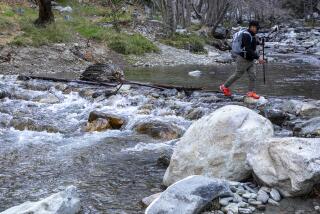Forestry Dept. Prepares for Blazing Summer as Brush Fire Season Nears
RIVERSIDE — Where there’s high heat and low moisture, there’s the danger of brush fire in California, especially when people are careless with equipment and combustible materials.
Monday marks the start of the 1987 brush fire season and the California Department of Forestry reports that, judging by this spring’s weather conditions, the state may be in for a blazing summer.
“We’re expecting an active fire season, especially if weather patterns continue as they’ve been so far,” said Capt. Brenda Seabert, a spokeswoman for the Forestry Department. “Things dried out early this year, we haven’t had the rain that we get on the average and we’ve had a couple of Santa Ana conditions.”
The fierce, hot Santa Ana winds that dry out vegetation and spread flames are one reason that Southern California becomes a giant tinderbox each year between May and November. High heat and low humidity provide the right environment for brush fires, and grasses and shrubs that are low in moisture provide the fuel.
But the chief contributor to the annual outbreak of raging brush fires is human negligence, Seabert said, and this is why the California Department of Forestry launches inspections and public information campaigns each spring.
Last year, nearly 4,500 fires blackened more than 23,000 acres in Riverside County, one of the state’s traditional hot spots. The single biggest factor, which caused 34% of the fires, was equipment malfunction, “anything from welding accidents to heat from the catalytic converters of cars,” Seabert said.
The second-biggest factor, responsible for 15% of the blazes, was “people playing with fire, especially children,” she added. Arson, accounting for 13.5% of all fires, was the third-largest cause.
Then there are quirky fires that just seem to ignite spontaneously. “We had an earthquake out here in the Desert Hot Springs area and the friction between the ground and the rocks started a fire on top of one of the mountain peaks,” Seabert said.
Whether sparked by nature or people, brush fires cost plenty. Total fire damage to Riverside County houses and property in 1986 was more than $20 million. That cost was matched by the combined state and local expenditures for fighting the county’s brush fires.
Prevention Efforts
Part of the firefighting budget is spent on prevention. Seabert said that each spring, when the forestry department starts recruiting seasonal firefighters and tuning up fire trucks, inspectors are sent out to see if homeowners are trimming back dangerous vegetation.
“The spring is our hazard-reduction phase,” she said. “We do premise inspections to check whether people are complying with local ordinances requiring 30 feet of clearance around houses.”
The department also advises residents to invest in landscaping and home improvements that will keep fire at bay.
“You can plant a green belt of fire-resistive vegetation, like ice plants that don’t dry out so quickly, around the house at 30 to 100 feet,” Seabert said. “And I’ve seen sprinkler systems on the roofs of expensive homes in high-fire areas.”
History has shown that California brush fires are indiscriminate disasters. One of the most devastating fires occurred in 1961 when flames swept through the exclusive Bel-Air and Brentwood residential sections, destroying the plush homes of such celebrities as Burt Lancaster, Zsa Zsa Gabor and Joan Fontaine.
The 1961 fire had all the elements of a classic Southern California conflagration: three years of local drought, three days of gusty Santa Ana winds and low humidity and dense growth of the dry grasses and chaparral that the Los Angeles Fire Department has called “the most flammable ground cover in the Western Hemisphere.”
After two days in which flames covered up to 13 acres a minute, 496 homes were destroyed, and insured property losses, always only a fraction of total fire losses, topped $24 million.
As part of its prevention efforts, the forestry service has begun a comprehensive study to chart the state’s brush fire history and determine if any significant patterns emerge.
Among other things, the study will explore whether certain locations are likely ignition sites (such as an area of Malibu Canyon where large-scale blazes started in 1970 and again in 1980) and whether the biggest blazes tend to occur after one or two mild seasons when ground cover, unchecked by major fire, has grown expansively.
Until the study provides better brush fire barometers, the forestry department will have to rely on short-term predictions based on early signs--and so far this season’s indicators spell trouble.
“Things have been starting to pick up already,” Seabert noted. As early as Feb. 9, a fire near Lake Elsinore spread over 280 acres, and 10 days later a blaze in the Thermal area of Coachella Valley engulfed 200 acres.
“It’s early for that kind of acreage,” Seabert said. “We think it’s going to be an active year, especially with the vegetation and weather patterns we’re seeing, and we’re gearing up for it.”
More to Read
Sign up for Essential California
The most important California stories and recommendations in your inbox every morning.
You may occasionally receive promotional content from the Los Angeles Times.










